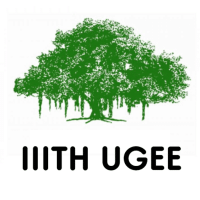JEE Exam > JEE Questions > Let ω be a complex cube root of unity w...
Start Learning for Free
Let ω be a complex cube root of unity with ω ≠ 1. A fair die is thrown three times. If r1, r2 and r3 are the numbers obtained on the die, then the probability that ωr1 + ωr2 + ωr3 = 0 is (2010)
- a)

- b)

- c)

- d)

Correct answer is option 'C'. Can you explain this answer?
Most Upvoted Answer
Let ω be a complex cube root of unity with ω ≠ 1. A fai...
If ω is a complex cube root of unity then, we know that ω3m +ω3n+1 +ω3p +2 = 0 where m, n, p are integers.
∴ r1, r2, r3 should be of the form 3m, 3n + 1 and 3p + 2 taken in any or d er. As r1 ,r2 ,r3 are the numbers obtained on die, these can take any value from 1 to 6.
∴ m can take values 1 or 2, n can take values 0 or 1p can take values 0 or 1
∴ Number of ways of selecting r1, r2, r3
= 2C1 x 2C1 x 2C1 x 3!.
Also the total number of ways of getting r1, r2, r3 on die = 6 × 6 × 6
∴ r1, r2, r3 should be of the form 3m, 3n + 1 and 3p + 2 taken in any or d er. As r1 ,r2 ,r3 are the numbers obtained on die, these can take any value from 1 to 6.
∴ m can take values 1 or 2, n can take values 0 or 1p can take values 0 or 1
∴ Number of ways of selecting r1, r2, r3
= 2C1 x 2C1 x 2C1 x 3!.
Also the total number of ways of getting r1, r2, r3 on die = 6 × 6 × 6
∴ Required probability=

Free Test
FREE
| Start Free Test |
Community Answer
Let ω be a complex cube root of unity with ω ≠ 1. A fai...
Favourable =2*2*2*3!=48
total=216
so p=2/9
total=216
so p=2/9

|
Explore Courses for JEE exam
|

|
Similar JEE Doubts
Question Description
Let ω be a complex cube root of unity with ω ≠ 1. A fair die is thrown three times. If r1, r2 and r3 are the numbers obtained on the die, then the probability that ωr1 + ωr2 + ωr3 = 0 is (2010)a)b)c)d)Correct answer is option 'C'. Can you explain this answer? for JEE 2025 is part of JEE preparation. The Question and answers have been prepared according to the JEE exam syllabus. Information about Let ω be a complex cube root of unity with ω ≠ 1. A fair die is thrown three times. If r1, r2 and r3 are the numbers obtained on the die, then the probability that ωr1 + ωr2 + ωr3 = 0 is (2010)a)b)c)d)Correct answer is option 'C'. Can you explain this answer? covers all topics & solutions for JEE 2025 Exam. Find important definitions, questions, meanings, examples, exercises and tests below for Let ω be a complex cube root of unity with ω ≠ 1. A fair die is thrown three times. If r1, r2 and r3 are the numbers obtained on the die, then the probability that ωr1 + ωr2 + ωr3 = 0 is (2010)a)b)c)d)Correct answer is option 'C'. Can you explain this answer?.
Let ω be a complex cube root of unity with ω ≠ 1. A fair die is thrown three times. If r1, r2 and r3 are the numbers obtained on the die, then the probability that ωr1 + ωr2 + ωr3 = 0 is (2010)a)b)c)d)Correct answer is option 'C'. Can you explain this answer? for JEE 2025 is part of JEE preparation. The Question and answers have been prepared according to the JEE exam syllabus. Information about Let ω be a complex cube root of unity with ω ≠ 1. A fair die is thrown three times. If r1, r2 and r3 are the numbers obtained on the die, then the probability that ωr1 + ωr2 + ωr3 = 0 is (2010)a)b)c)d)Correct answer is option 'C'. Can you explain this answer? covers all topics & solutions for JEE 2025 Exam. Find important definitions, questions, meanings, examples, exercises and tests below for Let ω be a complex cube root of unity with ω ≠ 1. A fair die is thrown three times. If r1, r2 and r3 are the numbers obtained on the die, then the probability that ωr1 + ωr2 + ωr3 = 0 is (2010)a)b)c)d)Correct answer is option 'C'. Can you explain this answer?.
Solutions for Let ω be a complex cube root of unity with ω ≠ 1. A fair die is thrown three times. If r1, r2 and r3 are the numbers obtained on the die, then the probability that ωr1 + ωr2 + ωr3 = 0 is (2010)a)b)c)d)Correct answer is option 'C'. Can you explain this answer? in English & in Hindi are available as part of our courses for JEE.
Download more important topics, notes, lectures and mock test series for JEE Exam by signing up for free.
Here you can find the meaning of Let ω be a complex cube root of unity with ω ≠ 1. A fair die is thrown three times. If r1, r2 and r3 are the numbers obtained on the die, then the probability that ωr1 + ωr2 + ωr3 = 0 is (2010)a)b)c)d)Correct answer is option 'C'. Can you explain this answer? defined & explained in the simplest way possible. Besides giving the explanation of
Let ω be a complex cube root of unity with ω ≠ 1. A fair die is thrown three times. If r1, r2 and r3 are the numbers obtained on the die, then the probability that ωr1 + ωr2 + ωr3 = 0 is (2010)a)b)c)d)Correct answer is option 'C'. Can you explain this answer?, a detailed solution for Let ω be a complex cube root of unity with ω ≠ 1. A fair die is thrown three times. If r1, r2 and r3 are the numbers obtained on the die, then the probability that ωr1 + ωr2 + ωr3 = 0 is (2010)a)b)c)d)Correct answer is option 'C'. Can you explain this answer? has been provided alongside types of Let ω be a complex cube root of unity with ω ≠ 1. A fair die is thrown three times. If r1, r2 and r3 are the numbers obtained on the die, then the probability that ωr1 + ωr2 + ωr3 = 0 is (2010)a)b)c)d)Correct answer is option 'C'. Can you explain this answer? theory, EduRev gives you an
ample number of questions to practice Let ω be a complex cube root of unity with ω ≠ 1. A fair die is thrown three times. If r1, r2 and r3 are the numbers obtained on the die, then the probability that ωr1 + ωr2 + ωr3 = 0 is (2010)a)b)c)d)Correct answer is option 'C'. Can you explain this answer? tests, examples and also practice JEE tests.

|
Explore Courses for JEE exam
|

|
Signup to solve all Doubts
Signup to see your scores go up within 7 days! Learn & Practice with 1000+ FREE Notes, Videos & Tests.
























